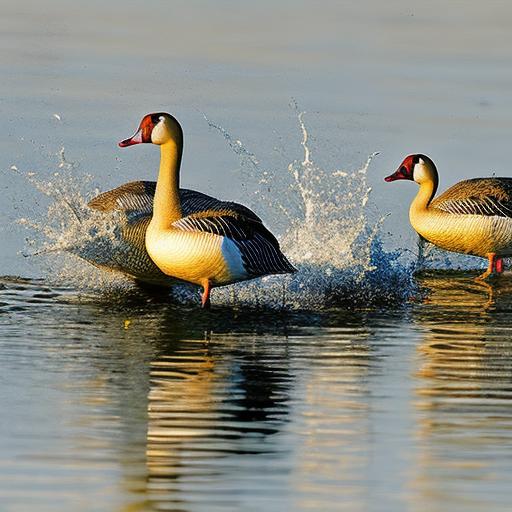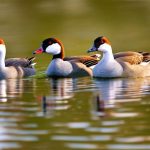The presence of geese in urban areas has become a growing problem in recent years. These birds, once primarily found in rural and natural habitats, have adapted to urban environments and are now causing issues for residents and businesses alike. Geese can be aggressive, leave behind large amounts of droppings, and damage property with their feeding habits. As a result, many communities are seeking effective methods to control geese populations and mitigate the problems they create.
There are several methods that can be used to control geese in urban areas. These methods range from physical barriers and decoys to noise deterrents and vegetation management. Each method has its own advantages and disadvantages, and the most effective approach may vary depending on the specific circumstances of the area in question. By understanding the behavior of geese and implementing appropriate control measures, communities can successfully manage geese populations and reduce the negative impacts they have on urban environments.
Key Takeaways
- Geese are social animals and tend to congregate in large groups.
- Physical barriers such as fences or netting can prevent geese from accessing certain areas.
- Decoys can be effective in tricking geese into thinking an area is already occupied.
- Loud noises such as air horns or banging pots can scare geese away temporarily.
- Planting tall grasses or shrubs can make an area less attractive to geese.
Understanding the behavior of geese
To effectively control geese populations, it is important to understand their habits and behavior. Geese are social animals that typically live in flocks. They are attracted to areas with open water, ample food sources, and suitable nesting sites. Geese are also known to be territorial and will defend their nesting sites aggressively. Understanding these behaviors can help in developing strategies to deter geese from urban areas.
Geese are attracted to certain areas for a variety of reasons. Open water, such as ponds or lakes, provides a suitable habitat for geese to swim and feed. These areas often have an abundance of grasses and other vegetation that serve as food sources for the birds. Additionally, urban areas often provide protection from predators and disturbances, making them attractive nesting sites for geese. By identifying and addressing these attractants, communities can discourage geese from settling in urban areas.
Creating physical barriers to deter geese
One effective method of controlling geese populations is the use of physical barriers. These barriers can be installed to prevent geese from accessing certain areas, such as lawns, parks, or golf courses. There are several types of physical barriers that can be used, including fences, netting, and floating barriers.
Fences are a common method of deterring geese. They can be made from a variety of materials, such as plastic or metal, and should be at least three feet high to prevent geese from flying over them. Fences should also be buried at least six inches into the ground to prevent geese from digging underneath them. Regular maintenance is necessary to ensure that fences remain intact and effective.
Netting is another option for creating physical barriers. It can be installed over bodies of water or vegetation to prevent geese from accessing these areas. Netting should be securely fastened and regularly inspected for any damage or gaps that may allow geese to pass through.
Floating barriers are often used in bodies of water to create a physical barrier between geese and certain areas. These barriers consist of floating ropes or buoys that are placed strategically to prevent geese from swimming or landing in specific locations. Regular maintenance is necessary to ensure that floating barriers remain in place and effective.
Installing decoys to trick geese
Another method of controlling geese populations is the use of decoys. Decoys are objects that resemble geese and are placed in areas where geese are not wanted. The presence of these decoys can trick geese into thinking that an area is already occupied, discouraging them from settling there.
There are several types of decoys that can be used, including stationary decoys and motion decoys. Stationary decoys are typically made of plastic or foam and are placed in visible locations, such as lawns or fields. Motion decoys, on the other hand, are designed to mimic the movement of real geese. These decoys often have wings that flap or heads that move, creating a more realistic appearance.
Proper installation and maintenance of decoys is essential for their effectiveness. Decoys should be placed in areas where geese are likely to land or feed, and they should be moved periodically to prevent geese from becoming accustomed to their presence. Additionally, decoys should be cleaned regularly to maintain their realistic appearance.
Using noise to scare geese away
Noise deterrents can also be effective in controlling geese populations. Geese are sensitive to loud or unexpected noises and will often flee from areas where these noises occur. There are several types of noise deterrents that can be used, including propane cannons, pyrotechnics, and ultrasonic devices.
Propane cannons are a common noise deterrent used to scare geese away. These devices produce loud bangs at regular intervals, creating a loud and unexpected noise that frightens geese. Pyrotechnics, such as bird bangers or screamers, can also be used to create loud noises and scare geese away. Ultrasonic devices emit high-frequency sounds that are unpleasant to geese but not audible to humans.
Proper use of noise deterrents is important for their effectiveness. Noise deterrents should be placed strategically in areas where geese are likely to gather or feed. They should be used consistently and at regular intervals to prevent geese from becoming accustomed to the noise. It is also important to follow local regulations and guidelines when using noise deterrents.
Planting vegetation to discourage geese

Planting certain types of vegetation can also help discourage geese from settling in urban areas. Geese prefer open grassy areas where they can easily access food sources and have a clear line of sight for predators. By planting tall grasses or shrubs, communities can create barriers that make it more difficult for geese to access these areas.
Tall grasses, such as switchgrass or big bluestem, can be planted along shorelines or in open areas to create a physical barrier that discourages geese from landing or feeding. These grasses should be planted densely and regularly maintained to ensure their effectiveness. Shrubs, such as holly or juniper, can also be planted to create barriers that make it more difficult for geese to access certain areas.
Proper planting and maintenance of vegetation is essential for its effectiveness. Grasses and shrubs should be planted in areas where geese are likely to gather or feed, and they should be regularly trimmed or pruned to maintain their density. It is also important to choose native species that are well-suited to the local climate and conditions.
Installing fencing to protect shoreline areas
Shoreline areas are often attractive nesting sites for geese, as they provide protection from predators and disturbances. Installing fencing along shorelines can help protect these areas and discourage geese from nesting there. There are several types of fencing that can be used, including wire mesh fencing and electric fencing.
Wire mesh fencing is a common option for protecting shoreline areas. It can be installed along the water’s edge to create a physical barrier that prevents geese from accessing nesting sites. The height of the fence should be at least three feet to prevent geese from flying over it, and it should be buried at least six inches into the ground to prevent geese from digging underneath it.
Electric fencing is another option for protecting shoreline areas. It consists of wires that are charged with electricity and emit a mild shock when touched. Electric fencing can be effective in deterring geese from nesting in certain areas, but it requires regular maintenance to ensure that it remains operational.
Proper installation and maintenance of fencing is important for its effectiveness. Fences should be installed securely and regularly inspected for any damage or gaps that may allow geese to pass through. Electric fencing should be regularly tested to ensure that it is functioning properly.
Removing food sources to discourage geese
One effective method of discouraging geese from settling in urban areas is to remove their food sources. Geese are attracted to areas with an abundance of grasses, grains, and other vegetation that serve as food sources. By removing or reducing these food sources, communities can make urban areas less attractive to geese.
There are several types of food sources that can attract geese, including lawns, golf courses, and agricultural fields. To discourage geese from feeding in these areas, communities can implement strategies such as reducing irrigation or fertilization, using alternative landscaping methods, or implementing targeted grazing programs.
Reducing irrigation or fertilization can help make lawns and other grassy areas less attractive to geese. By reducing the amount of water or nutrients available, communities can create conditions that are less favorable for geese to feed and thrive. Alternative landscaping methods, such as using native plants or ground covers, can also help reduce the attractiveness of certain areas to geese.
Implementing targeted grazing programs can be an effective way to manage vegetation in areas where geese are a problem. Grazing animals, such as sheep or goats, can be used to control the growth of grasses and other vegetation, making these areas less attractive to geese. Proper management and rotation of grazing animals is important to ensure that vegetation is controlled effectively.
Utilizing trained dogs to scare geese off
Trained dogs can be an effective tool for scaring geese away from urban areas. Dogs have a natural instinct to chase and herd animals, and their presence can deter geese from settling in certain areas. There are several benefits to using trained dogs for geese control.
One benefit of using trained dogs is their ability to cover large areas quickly and efficiently. Dogs can be trained to patrol specific areas and scare geese away, preventing them from settling or feeding in these areas. Dogs can also be trained to respond to specific commands or cues, allowing for greater control and flexibility in geese control efforts.
Proper training and use of dogs is important for their effectiveness. Dogs should be trained to respond to specific commands or cues, such as “leave it” or “go away,” and should be regularly exercised and socialized to maintain their effectiveness. It is also important to follow local regulations and guidelines when using dogs for geese control.
Implementing repellent sprays or gels
Repellent sprays or gels can be an effective method of controlling geese populations in certain areas. These products are designed to create an unpleasant taste or smell that deters geese from feeding or settling in specific locations. There are several types of repellents that can be used, including chemical repellents and natural repellents.
Chemical repellents often contain ingredients such as methyl anthranilate or capsaicin, which create an unpleasant taste or smell that deters geese. These repellents can be sprayed directly onto vegetation or other surfaces, creating a barrier that geese are reluctant to cross. Natural repellents, on the other hand, often contain ingredients such as garlic or peppermint oil, which create a strong odor that repels geese.
Proper application of repellents is important for their effectiveness. Repellents should be applied according to the manufacturer’s instructions and reapplied as necessary to maintain their effectiveness. It is also important to choose repellents that are safe for the environment and non-toxic to humans and other animals.
Seeking professional help for geese control
In some cases, seeking professional help may be necessary to effectively control geese populations in urban areas. Professional wildlife management companies have the knowledge, experience, and resources to develop and implement comprehensive geese control strategies. There are several benefits to seeking professional help for geese control.
One benefit of seeking professional help is the expertise and knowledge that professionals bring to the table. Professional wildlife management companies have a deep understanding of geese behavior and biology, as well as the most effective control methods and techniques. They can assess the specific circumstances of an area and develop a customized geese control plan that addresses the unique challenges and needs of the community.
Another benefit of seeking professional help is the resources and equipment that professionals have access to. Professional wildlife management companies often have specialized equipment, such as noise deterrents or trapping devices, that can be used to effectively control geese populations. They also have the necessary permits and licenses to implement certain control methods, such as trapping or relocation.
Finding a reputable professional wildlife management company is important for effective geese control. It is recommended to research and compare different companies, read reviews or testimonials, and ask for references before making a decision. It is also important to ensure that the company is licensed, insured, and follows ethical and humane practices in their geese control efforts.
Controlling geese populations in urban areas requires a comprehensive approach that addresses their behavior, habits, and specific attractants. By implementing a combination of physical barriers, decoys, noise deterrents, vegetation management, fencing, food source removal, trained dogs, repellents, and professional help, communities can successfully manage geese populations and reduce the negative impacts they have on urban environments. It is important for residents and businesses to take action to control geese in their area to ensure a safe and clean environment for all.
If you’re looking for effective ways to keep geese off your shoreline, you might also be interested in learning about the best kind of coop for chickens. Poultry Wizard has a helpful article that discusses what kind of coop is best for chickens, providing valuable insights on the different types of coops available and their advantages. Understanding the right coop design can not only ensure the safety and comfort of your chickens but also help in keeping unwanted visitors like geese at bay. Check out the article here to discover more about creating an ideal home for your feathered friends.
FAQs
What are the reasons for keeping geese off the shoreline?
Geese can cause damage to the shoreline by trampling vegetation, leaving droppings, and disturbing the natural habitat of other wildlife. They can also pose a health risk to humans due to their fecal matter.
What are some effective ways to keep geese off the shoreline?
Some effective ways to keep geese off the shoreline include using decoys, installing fencing or netting, using noise deterrents, and planting vegetation that geese do not like.
What are some natural ways to keep geese off the shoreline?
Some natural ways to keep geese off the shoreline include planting vegetation that geese do not like, using natural predators such as dogs or hawks, and creating a natural barrier such as a rocky shoreline.
Is it legal to harm or kill geese to keep them off the shoreline?
No, it is not legal to harm or kill geese to keep them off the shoreline. Geese are protected under the Migratory Bird Treaty Act, and harming or killing them can result in fines and legal consequences.
What should I do if I encounter an injured or sick goose on the shoreline?
If you encounter an injured or sick goose on the shoreline, it is best to contact a local wildlife rehabilitation center or animal control agency. Attempting to handle or care for the goose yourself can be dangerous and may further harm the animal.
Meet Walter, the feathered-friend fanatic of Florida! Nestled in the sunshine state, Walter struts through life with his feathered companions, clucking his way to happiness. With a coop that’s fancier than a five-star hotel, he’s the Don Juan of the chicken world. When he’s not teaching his hens to do the cha-cha, you’ll find him in a heated debate with his prized rooster, Sir Clucks-a-Lot. Walter’s poultry passion is no yolk; he’s the sunny-side-up guy you never knew you needed in your flock of friends!







